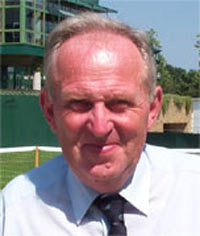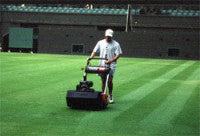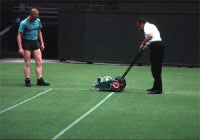Catching up at Wimbledon
Catching up at Wimbledon
By Eddie Seaward

Like most of my compatriots I have found this spring to be very challenging, the cold, dry weather resulted in little or no real significant grass growth during March and April.
At one point it looked like we may have been three weeks behind schedule, however, the recent change in air and soil temperatures has advanced our growing conditions and brought us back on track.
We applied a dose of Spearhead (active ingredients Clopyralid +Diflufenican +MCPA), a selective weed killer, early in April to eradicate some small weed seedlings that had found their way onto the courts during the winter period.
All our match courts were hydra jetted to a depth of 100mm (4"), using micro tines, to open up the courts and allow some air movement through the soil profile.
Our spring renovations tend to follow the same pattern each year. We started with a programme of verticutting and oversowing in mid April. To help maximise seed germination we covered the courts three days prior to sowing, and then kept them on for three days afterwards.
We continue to use AberElf and AberImp perennial ryegrasses on the courts. These species are very dominant and have helped control the poa grasses which, in turn, has reduced the susceptibility of the sward to turf disease.

We have noticed a marked decrease in disease incidents on the courts, in part due to the fact that we have more air circulation around the grass plant, and less poa because of the cultivation treatment we now undertake. As part of our end of season renovations we fraise mow all our courts, completely cleaning out all the poa and leaving a clean ryegrass sward to rejuvenate itself ready for the new season.
The courts are now being mown at 12mm and will be brought down to 9mm ready for the start of our membership play on the 21st May. The grass height will be further reduced to 8mm for the Championships in June.
Our rolling programme is ongoing, we are currently using our six 1ton 4ft (1200mm) wide rollers. I am pleased with the hardness of the courts considering the programme has been affected by the recent dry weather.

Well over half of the temporary staff are already here and we are waiting for the remainder who are due to arrive this week. They have all settled in very quickly and are getting used to the rigors of pre championship preparations.
The court covers are coming in this week to be fitted and tested, and another 160 staff will be recruited specifically to operate them during the Championships.
Next week is when we begin marking out the courts, using a wheel-to-wheel Prince line marker that produces the quality of line we desire. We use well over 500 gallons of white lining paint during the Championships.
From the start of June companies are busy erecting the grandstands, seating and marquee areas that are so familiar to visitors to the event. This involves shutting down all the artificial tennis facilities and dismantling the fittings to allow access for the contractors to complete their works.
In total, 41 grass courts are prepared for the Championships, all of which are maintained in the same manner using the same materials and maintenance regimes to ensure total consistency and uniformity.
My staff use a number of monitoring devices to measure surface performance and quality. A Clegg hammer is used to measure court hardness. The aim is for the Clegg hammer to be reading 150 gravities two days prior to the Championships, and then maintain this level throughout.
Ball bounce testing is also carried out by the STRI, who constantly monitor court performance along with sward density testing.
Watering is very important when preparing the courts. The rootzone needs to be wet uniformly with the water reaching below 100mm to encourage deeper rooting. When rolling, my staff can then be confident of consistent consolidation at depth.
Feeding this year has been restricted by the conditions, however we did manage to apply an autumn feed in February and, since then, followed up with a spring 14/0/5 fertiliser last week. We then aim to apply a couple of liquid feeds prior to the Championships to colour up the courts, without getting them too lush.
As soon as the Championships have finished the renovation programme begins all over again, with the Centre and No 1 courts completed first. The remaining courts follow, bearing in mind that the club members will still be wanting to play. By late August, all being well, the programme will be completed.
